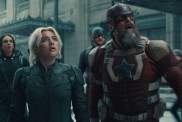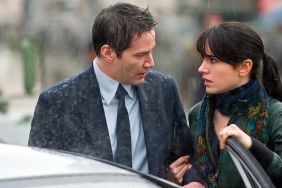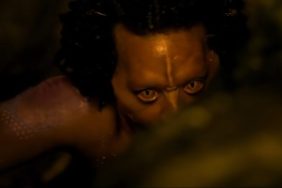“Keep watching the skies!” was a caveat in the early 1950s that reverberated through much of cinema’s atomic age colonized by aliens, giant beasties and mutated men. And although that popular phrase (in its entirety being “Watch the skies, everywhere! Keep looking. Keep watching the skies!”) is attributed to Howard Hawks’ The Thing from Another World, as spoken by co-star Douglas Spencer, any sci-fi junkie knows it could have been applied to a number of extraterrestrial films like Joseph Newman’s This Island Earth and Earth vs. the Flying Saucers featuring the stop-motion craftsmanship of Ray Harryhausen. And, of course, there’s 1951’s The Day the Earth Stood Still, released only a few months after Hawks’ aforementioned contribution.
Directed by Robert Wise – whose varied career would have him go on to do The Haunting, West Side Story and Star Trek: The Motion Picture – “Day” tapped into a turbulent political climate and a second wave of Red Scare fears simmering through the ’40s and ’50s. Michael Rennie starred as dapper alien Klaatu who arrives on Earth in his flying saucer, with a towering robot pal/weapon named Gort, and issues a directive to the leaders of the world: Live in peace or face annihilation. At least, that’s a distilled version of his message. Along the way, Klaatu is pursued by government officials (landing in Washington makes you a high profile visitor) while he befriends a young boy and learns a thing or two about the human race.
It’s a damn chilly February afternoon in Vancouver when ComingSoon.net visits the set of 20th Century Fox’s The Day the Earth Stood Still remake directed by Scott Derrickson. It’s his first time back at the camera following 2005’s The Exorcism of Emily Rose which scared up some success for distributor Screen Gems. In the three years since that Jennifer Carpenter-starring possession film, Derrickson has also been attached to Paradise Lost, however, he opted to modernize Wise’s film instead. (For a full interview with Derrickson, his cast and producer click here.)
With screenwriter Dan Scarpa (The Last Castle), Derrickson’s ushering the sci-fi allegory into the 21st century with a narrative that maintains a faithfulness to the original and finds Keanu Reeves as a visitor from space who arrives on Earth with a mission to fulfill. And in doing so, the entire planet is in a state of panic.
Inside Stage B at the Vancouver Film Studios, we find a lively and charming Canadian crew (hockey is on the lips of many, go figure) poised for the next film set-up. “Klaatu 2008” Reeves trudges passed us in a hospital gown heading towards a sterile laboratory set. He’s joined by Jennifer Connelly, here playing Helen (a role previously essayed by Patricia Neal), and Jon Hamm of “Mad Men” – scientists who have a seemingly comatose Klaatu under observation in a clear oxygen tent. Derrickson readies the scene, Reeves settles himself on a table and is covered with the tent by crew members. It’s a two-camera set-up, one fixed on Connelly, the other on Reeves. Everyone settles down and a take plays out…
Connelly steps into the lab, monitoring Reeves who awakens pounding on the delicate walls that confine him. Hamm rushes in, lab scientists bustle about (“Subject is conscious!”). Then, a moment between Reeves and Connelly as his eyes locks on hers. Hamm utters, “It recognizes you.” Derrickson calls for a cut and the crew rushes in to free Reeves and fix the tent he was smashing against. By the fourth take, the scene is coming together and by the fifth Derrickson has what he was looking for.
Earlier in the day ComingSoon.net convened with some of the behind-the-scenes techs bringing this redo to life. Arriving at the productions office, we’re greeted by production designer David Brisbin, visual effects supervisor Jeff Okun and the quiet visual effects producer Thomas Boland. We’re directed into a creative “war room” of sorts where the trio guides us through storyboards, conceptual art and other photographs that adorn the walls surrounding us.
In designing The Day the Earth Stood Still “the elephant in the room was obviously the original film and when we looked at it, you see this stuff that matches today so nicely,” Brisbin begins, “the media, the wartime setting and just being on the threshold of mass paranoia. It was right at the edge of ‘fear of annihilation from nuclear something.’ Now we’re at right at the threshold of ‘fear of annihilation by eco something.’ With all of those parallels, there’s one huge difference between [the original film] and the 2008 audience. The 2008 audience has been to outer space. A lot. With Lucas, with Spielberg, Ridley Scott – it’s a known thing in a way that in 1951 it just wasn’t. So, we knew we had to make a completely different film.”
Different not so much in story, but in its approach. And what Derrickson and his design team opted for was realism. That’s a word that holds heavy meaning and is repeated throughout our conversation with Brisbin and Okun. “We have quite a burden in that the original movie is quite an icon,” says Okun. “A lot of the images in The Day the Earth Stood Still actually happen in this movie, we’re more dealing with the interpretation of it. Scott has a specific take on this.” Looking all around at the art on display, there is no glimmer of the archetypal designs seen in the ’51 film (and other sci-fi films of its ilk), but there are echoes of Wise’s work (a one-sheet for the original hangs proudly by the door).

We spy modern day designs for labs, other government locations, and landscapes notably intruded by colorful “spheres.” The largest of them all is situated in New York City’s Central Park. Several conceptual pieces feature a bluish sphere hovering above the ground; dark cloud formations crackling with lightning are in the sky. Another sphere lies in a swamp. And another rises out of the ocean.
Brisbin speaks with hesitation when it comes to the “orbs,” as he calls them, but confirms they are “the conveyance in which Klaatu arrives. There are different orbs in the picture.” If that’s the case, why the decision to nix the flying saucer? “The reason I don’t think you can do the same thing is that for a lot of people there’s nothing more old fashioned than a flying saucer,” he explains. “How can you say a flying saucer landed? There were reports of one in Texas recently. But it’s not in the New York Times, it’s in the Enquirer. It’s funny. In the original, it wasn’t meant to be funny. Back then [they saw it] and said, Oh, shit! How do you get people in 2008 to say, Oh, shit?”
Okun, Boland and their team are the ones responsible for Klaatu’s arrival on Earth and they prep a pre-viz reel for us to see. Before doing so, Okun says, “What is the sphere? Conceptually what the sphere is is it’s neither a physical entity of hard surfaces or a ball of gas. It’s closer to a physical portal, there is no inside. At one point in the script we went inside the thing and it was this white limbo-y thing. We thought that was cheesy.”
The video presentation begins and we get our first glimpses of the spherical ship. The effects are still crude, blocky, but we get the gist. On screen, a representation of Helen sits in a helicopter, watching a mammoth sphere breach Central Park. Its descent blows a violent gust of wind outwards in the direction of the surrounding onlookers and welcoming committee of government and Army personnel who have gathered around. There are plenty of aerial shots to give the scene scope and intensity.
Setting the ship’s arrival in New York City was a big subject of debate, says Brisbin. “We’re aware New York is used a lot for these invasion movies and there was this consideration of whether we were going to do it in Washington D.C. or New York,” he explains. “We scouted them both very seriously to figure it out and we got the call not to use Washington on the part of Scott Derrickson because he felt it didn’t have the geometry that he was after that exists in New York. Central Park functions as a jewel box and the landing takes place there. It’s hard to beat that. It’s hard to find that much space packed around one little piece of ground. If you’re going to land somewhere where would you want to land?”
A second scene is a continuation of the landing: Klaatu’s departure from his space craft. Again, really rough. The action is clear, however. As the Army rolls in closer to the ship, a team in bio-suits approaches cautiously. Klaatu – his form is vague and purposely undefined at this stage in the FX – exits. Somewhere, a soldier with an itchy trigger finger fires. Klaatu is shot and he goes down. There’s confusion. No one knows where the shot came from. Then, Klaatu’s sphere begins to change hue, from a bluish green to a menacing red.
“Conceptually, we used the [color changing orb] as an emotion device,” Okun says addressing the scene. “It’s nascent state is this green thing and when Klaatu is shot, a prelude to Gort, things become [red]. Later in the film, you see the sphere doing other things. You learn there is more than one sphere and they have a lot of different purposes. They land through everywhere and come through all of time, the movie opens earlier and you get a glimpse of something that could be a sphere, whether it’s one or not you have to decide.”
Brisbin continues, “There is something about color in Scott that’s off the charts, he’s obsessed with color. You can have an enormous football stadium and have one red tomato fall and he’d say, ‘Brisbin, what’s that red doing there? We don’t do red.’ He’s so obsessed about condensing it to a very specific space. We went through that in ‘Emily Rose.’ On this one, what are the pieces that would give us the palette that would resonate psychologically with the story? He’d bring in images and I’d bring in images. We’ve gone through ten or fifteen rounds of this stuff.”
He guides our attention to a photo collage. A wide-ranging pallet of colors. They’re collated so all the orange photos (one featuring lava, for instance) are together; the blues (a slaughterhouse pic stands out) sit in the corner bleeding into the purples (a city skyline). These shades figure prominently into many of the conceptual pieces and we can begin to match up which photos torn from their books for inspiration set the tone for pictures featuring the introduction of what appears to be Gort.

“Gort is big. He’s really big,” teases Brisbin. According to the production designer, he’ll stand between 25 – 30 feet tall. “There was an interesting evolution in getting to our Gort. People are going to laugh if he comes out like a robot. How do you seriously do a robot in 2008? So, we started going down a path of having him come out in a different guise, not necessarily in humanoid form. It wandered away from humanoid form to prone creatures, mutations, every conceivable creature. We went way down those paths. At the end of the day there was that magical moment when we went, you know what? He actually has to be humanoid. How he gets to that form is a secret. But he does maintain a humanoid form.”
The early stages of Klaatu’s visage went through a similar creative process as Okun, Boland and Derrickson struggled to understand what form he could realistically take and why. “Klaatu isn’t anything we can conceive of, therefore it’s odd to think he would spend any time confined to space travel across the universe,” Okun says. “[The sphere] is a portal in the Star Trek ‘beam me up Scotty’ thing, but it travels on its own. It gets here and he comes. More interesting is why is he coming out as a humanoid? What if Klaatu’s physical presence is not one as we know it? Not only do they want to present themselves in a form we could understand, but one that would not threaten us. We have several phases to what he is. When you first see the alien, he’s first made up of molded light that doesn’t follow the laws of physics in that it’s contained without having a vessel. This is what we call his alien phase, through the course of the next couple of sequences he changes from the alien to a grey flesh creature then he’s revealed as a full grown human being who’s vulnerable and unprotected.”
A hint of the “grey flesh creature” he refers to is featured in a number of production sketches. Klaatu is seen in an alien “husk,” a “walking womb” that protects him as he goes to another planet. It’s humanoid, for sure, but the head is a striking shape. Thick, durable. “By means of surgery he achieves human form,” Brisbin reveals. “It is organic. There’s such a combination of lighting, visual effects, special effects, puppeteering to make this look like one of the great operations in history and will hopefully set alien operation precedence with that.”
Taking on such a task is Slither‘s Todd Masters who arrives to meet us packed with sample pieces of Klaatu’s suit nicknamed “the grey.” “We took what was done by other companies in the computer, months before we came aboard, and created a maquette or miniature sculpture so the director could start seeing something for real. Then we started to make all of these disgusting tests,” Masters proudly says handing us an alien arm. What we hold, we’re told, is an alien skin created by thermal plastic and silicones. “We hired a gentleman in the sex toy business and he had some of the greatest tools I’ve ever seen. So we brought him on and bought a sex toy making machine and now we can make this weird stuff that nobody else can make.”
In talking with this quartet today, it’s apparent much care went into conceiving a new vision on an old classic. Every decision is key. Every detail heavily researched. Without a doubt Derrickson has surrounded himself with an impressive array of talent to ease fans of the original The Day the Earth Stood Still into a new era and give them further reason to keep watching the skies.
Look for the Fox release in theaters and IMAX on December 12th.









